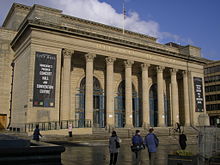| Revision as of 15:51, 26 September 2008 editThe Anomebot2 (talk | contribs)Bots, Extended confirmed users1,043,658 edits Replacing geodata: {{coord|53.3808|N|1.4724|W|scale:1000_region:GB|display=title}}← Previous edit | Revision as of 05:16, 6 October 2008 edit undoLightbot (talk | contribs)791,863 edits Date links per wp:mosnum/OtherNext edit → | ||
| Line 5: | Line 5: | ||
| The large hall dominates '']'', one of Sheffield's central ], which also contains the city's ]. | The large hall dominates '']'', one of Sheffield's central ], which also contains the city's ]. | ||
| The building was designed in |
The building was designed in 1920 by ], but was not completed until 1932.<ref></ref> It is a ] with a giant ]. The Oval Hall is the largest ] in the building, seating 2,271 people and is commanded by an ]. This provides both natural light to the main hall and can also be used by a hidden choir whose voices are carried through the building and down onto the audience. | ||
| The Oval Hall is complemented by the more intimate 500-seater Memorial Hall and the Ballroom which can host anything from after show parties to club nights and afternoon tea-dances. | The Oval Hall is complemented by the more intimate 500-seater Memorial Hall and the Ballroom which can host anything from after show parties to club nights and afternoon tea-dances. | ||
Revision as of 05:16, 6 October 2008

Sheffield City Hall is a Grade II* listed building in Sheffield, England, containing several venues, ranging from the Oval Concert Hall which seats over 2,000 people to a ballroom featuring a sprung dance floor.
The large hall dominates Barker's Pool, one of Sheffield's central squares, which also contains the city's War Memorial.
The building was designed in 1920 by E. Vincent Harris, but was not completed until 1932. It is a neo-classical building with a giant portico. The Oval Hall is the largest hall in the building, seating 2,271 people and is commanded by an angel's chorus. This provides both natural light to the main hall and can also be used by a hidden choir whose voices are carried through the building and down onto the audience.
The Oval Hall is complemented by the more intimate 500-seater Memorial Hall and the Ballroom which can host anything from after show parties to club nights and afternoon tea-dances.
In 2005, the City Hall and its surroundings were refurbished and re-developed at a cost of £12.5million.
The hall is managed by the Sheffield City Trust, under a 99 year lease.
References
- English Heritage (1973) City Hall. Images of England (accessed 20 February 2006).
- Sheffield City Hall website
53°22′51″N 1°28′21″W / 53.3808°N 1.4724°W / 53.3808; -1.4724
Categories: